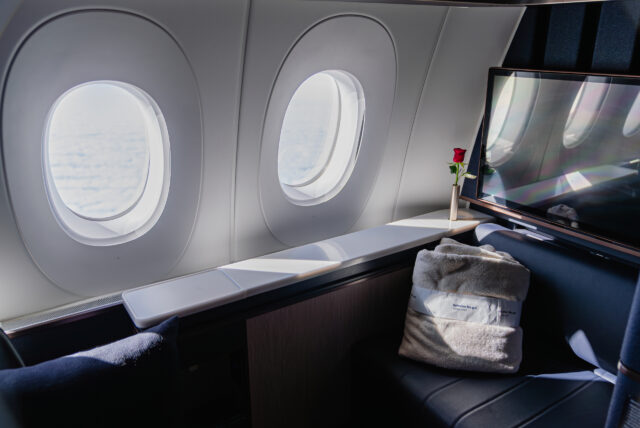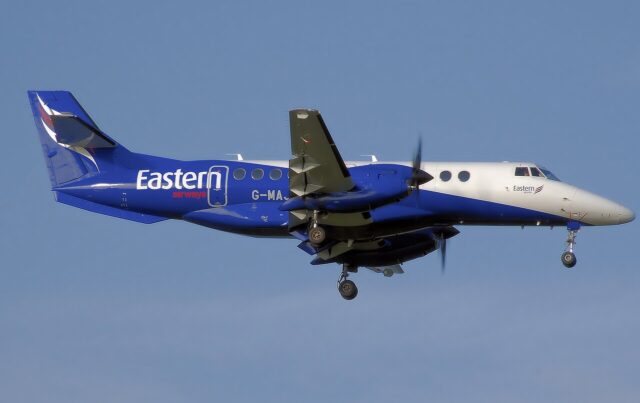A look inside Cosmic Aerospace’s all-electric Skylark regional aircraft before its 2030 launch

October 18, 2025

Cosmic Aerospace is developing Skylark, an all-electric 24-seat aircraft, specifically designed for regional operators on Essential Air Service routes in the US and public service operations in Europe. The company has set a target in-service date of 2030. The aircraft will feature a unique interior design that prioritises passenger comfort.
Aerospace Global News spoke with Cosmic Aerospace’s CEO, Christopher Chahine, about the aircraft’s ongoing development process and with Daniel Clucas, Founder and Design Director at StudioID, London, about the new cabin’s design.
Cosmic Aerospace’s all-electric Skylark promises a 1,000-km range at 50% lower operating costs
Chahine told AGN that Cosmic Aerospace’s Skylark 24-seat all-electric aircraft was designed from the ground up to operate on electric power. The aircraft utilises composites to reduce weight, with a proprietary embedded wing design and multiple hyperdrive electric-powered engines. When completed, the Skylark will be capable of flying up to 1,000 km, carrying 24 passengers.

“We’ve looked into the technology in a way to maximise its potential for the market need rather than going in with an existing technology and an aircraft and retrofitting that with a new powertrain, where you always end up with a sub-optimal solution which has some drawbacks in one dimension or the other,” Chahine told AGN.
Chahine said the Skylark will offer better operating economics compared to conventional aircraft, due to its lower mechanical complexity and higher energy efficiency.
An all-electric aircraft designed with the needs of regional airlines in mind
The aircraft was designed to meet the needs of regional operators for both scheduled and non-scheduled charter flights, particularly in markets such as EAS routes in the US or public service obligations in Europe.
Chahine told AGN that the aircraft could make these routes profitable without subsidies. “The size really fits very well into that segment where you could not go in with a larger conventional aircraft because they’re just too expensive,” he said.
A cabin suited for an ultra-lightweight Skylark
Designing a low-weight cabin is essential to ensuring the Skylark’s range and efficiency, but the company also wanted the aircraft to be modern and comfortable. This was the brief that Daniel Clucas took on.
The 24 seats onboard will be arranged in a 2-2 configuration. Clucas foresees using airline industry seats that utilise advanced materials to reduce weight. He has also been exploring the use of lightweight and environmentally friendly materials, such as synthetic leather and suede, as well as lightweight carpets.

“By the time we get to market with this, which is still realistically, I think, five years away, we’re going to be making sure that every material we use will be the most lightweight, the most environmentally friendly,” Clucas told AGN. “Things will move a long way in five years. So we’re not quite nailing anything down yet, but we’re saying these are the directions we want to move in.”

No overhead bins on the Skylark
The Skylark will not have any overhead bins. Instead, the aircraft will feature a front luggage storage solution capable of accommodating 24 full-sized roller bags, inspired by the CRJ550 storage rack. Passengers would simply deposit their bags when entering the aircraft and then find their seats, streamlining boarding and deplaning.
“There was an option to use these smaller half-sized bins, but the feedback we’ve received on those was that nobody likes them because you can’t really fit any proper bag in there anyway,” Chahine said.

The interior layout includes a lavatory and a galley with room for two standard-sized carts. Clucas has included a visually striking ceiling lighting design, inspired by “hyperspace,” to convey excitement and the aircraft’s speed.
The Skylark will feature larger windows than other regional aircraft, enhancing the interior feel by providing more natural light and visibility.
“We didn’t want it just to look like another regional aircraft interior,” Clucas said. “We wanted to make a bold impression to really make people feel excited about this. This is electric aviation. It’s totally new. It’s going to feel different. It’s going to look different.”
Airlines could customise seat covers, armrests, and carpets, with specific areas designated for branding, while avoiding extensive hardware redesigns to prevent added weight and testing.
Skylark advances through successful demonstrator flight tests
In October of last year, Cosmic Aerospace completed the flight test campaign of its first demonstrator aircraft, CX-1, at an airfield near Cosmic’s facility in Denver, Colorado.
The CX-1 had a 2.5-metre wing span and was equipped with 10 embedded engines.
Cosmic immediately began developing its subsequent demonstrator aircraft, the CX-2, which is twice the size of the CX-1. It has a 4.5-metre wingspan with 32 embedded electric engines. The company has conducted nine successful flight tests with the CX-2. In September of this year, Cosmic Aerospace also performed the European debut flight of CX-2 in Belgium.
Chahine acknowledged the significant certification process ahead and the collaboration required with regulators in the US and Europe to ensure the new propulsion systems meet safety standards, but remained firm in the planned 2030 entry into service. “Based on our learning so far, we think that the end of this decade is feasible,” he said.
If Cosmic Aerospace can deliver, airlines that provide essential air services will have a more sustainable aircraft option, both financially and environmentally.
















